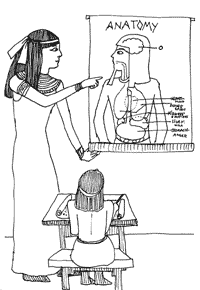All heart: Old anatomy a no-brainer

DRAWING BY DEBORAH DERR McCLINTOCK
Q. "Heartless" people aren't really without a heart, so why the terminology? –T. I. N. Man
A. Because in the ancient world, reaching back 5,000 years to the great civilizations of Egypt and Mesopotamia, the brain was regarded as an unimportant organ, since in death it is bloodless and in life it is seldom felt by its owner, says Richard L. Gregory in Eye and Brain: The Psychology of Seeing. The mind was associated with the stomach, liver, gall bladder, and especially the heart, which is clearly responsive to emotion and effort. "Echoes linger from these ideas in modern speech, in words such as 'phlegmatic,' 'gall,' 'choleric,' as well as 'heartless.'"
The vital role of the brain in movement, speech, thought and perception only became clear from the effects of accidents, when there was brain damage. Later, the effects of tumors and gunshot wounds gave further insight. Today PET scans and MRIs can show which regions are active during reading, seeing, imagining, etc. It has been said that the brain is "the only lump of matter we know from the inside"!
Q. As all too many in the world know all too well, a hurricane can be a fearsome thing. How much power does one have, and where does it come from? –P. Michaels
A. Hurricanes are among the most powerful of Earthly phenomena, unloosing some 1,000,000,000,000,000 Watts, 3,000 times the total electrical power generated in the world, say physicists Andrew Gavrin and Gregor Novak of Indiana University-Purdue University-Indianapolis. This is equivalent to exploding 500,000 Hiroshima-type atomic bombs per day. The fundamental source of this power is the condensation of water. Think how much heat energy it takes to boil off a kettle of water, about 2,250,000 joules of energy for a kilogram. The reverse of this happens in a storm, where the water is condensed instead of evaporated, making available a huge quantity of energy.
The necessary ingredients for a hurricane are a large area of warm ocean water, which provides the energy, and other factors that get the storm organized and going. Condensing moisture in a low pressure region releases energy, heating the air, which rises and pulls in more air from around the outside toward the center. Now add in the Coriolis force from the spinning Earth, and a whale of a whirl ensues. A hurricane can continue for many days over open water, but over land the lack of moisture and increased friction will slow it– though often not before much human grief has been delivered.
Q. Would an Earth scientist today agree with the poet's rendering, "This is the way the world ends, not with a bang but a whimper"? –R. Frost
A. The bang might be the massive meteorite slamming into Earth some 66 million years ago and killing off the dinosaurs, say Brian J. Skinner et al. in The Blue Planet: An Introduction to Earth System Science. But an even more dramatic extinction occurred 180 million years before that, with 90 percent of plant and animal species perishing. Yet no evidence of a meteorite exists for that one, rather the whimper of a slow but drastic climate change from the breakup of a huge super continent.
So pick your armageddon: Continual small changes over time such as the effects of human activities altering the planet's atmosphere, weather, oceans; or rare events that are nonetheless repeated at wide intervals. For example, the National Aeronautics and Space Administration reports that about 100 "near-Earth" objects have already been discovered on orbits that take them so close to our planet's orbit that a collision could occur. "Although their orbits do not intersect Earth's orbit at present, they could hit in a few thousand years or more."
Q. One of the world's truly noxious substances is hydrogen cyanide gas, generated when solid sodium or potassium cyanide combines with concentrated sulfuric acid, smelling a bit like bitter almonds, but the pleasantness stops there. Historically, when has this gas been used? –O. B. Laden
A. The Nazis used it as "Zyklon B" in their gas chambers during World War II, says chemist Joe Schwarcz in Dr. Joe and What You Didn't Know. Some U.S. states have used it in their capital punishment gas chambers. And firemen battling blazes can encounter it when wool, silk, nylon, certain carpetings go up in smoke. In an extremely intense fire, the hydrogen cyanide itself burns, producing harmless carbon dioxide, nitrogen dioxide and water. The hydrogen cyanide gas is deadly because it cuts off the body's ability to use oxygen.
Send Strange questions to brothers Bill and Rich at .
#